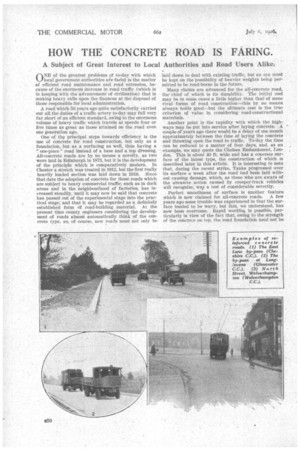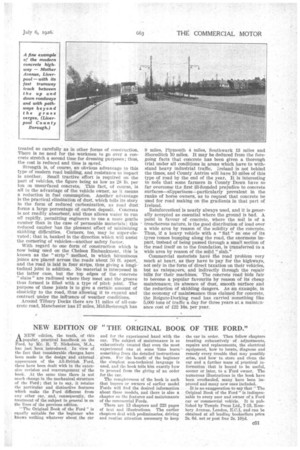HOW THE CONCRETE ROAD IS FARING.
Page 40

Page 41

If you've noticed an error in this article please click here to report it so we can fix it.
A Subject of Great Interest to Local Authorities and Road Users Alike:
ONE of the greatest problems of to-day with which local government authorities are faced is the matter of efficient road maintenance and road extension, because of the enormous increase in road traffic (which is in keeping with the advancement of civilization) that is making heavy calls upon the finances at the disposal of those responsible for local administration.
A road which 50 years ago quite satisfactorily carried out all the duties of a traffic artery to-day may fall very far short of an efficient standard, owing to the enormous volume of heavy traffic which travels at speeds four or five times as great as those attained on the road even one generation ago.
One of the principal steps towards efficiency is the use of concrete for road construction, not only as a foundation, but as a surfacing as well, thus having a " one-piece" road instead of a base and a top dressing. All-concrete roads are by no means a novelty, as two were laid in Edinburgh in 1873, but it is the development of the principle which is comparatively modern. In Chester a stretch was treated in 1912, but the first really heavily loaded section was laid down in 1919. Since that date the adoption of concrete for those roads which are subject to heavy commercial traffic, such as in dock areas and in the neighbourhood of factories, has increased steadily, until it may now be said that concrete has passed out of the experimental stage into the practical stage; and that it may be regarded as a definitely established form (if road-building material. At the present time county engineers considering the development of roads almost automatically think of the concrete type, as, of course. new roads must not only be laid down to deal with existing traffic, but an eye must be kept on the possibility of heavier weights being permitted to be road-borne in the future.
Many claims are advanced for the all-concrete road, the .chief of which is its durability, The initial cost may be in some cases a little higher than that of some rival forms of road construction—this by no means always holds good—but the ultimate cost is 'the true criterion of value in considering • road-constructional materials.
Another point is the rapidity with which the highways may be put into service after laying concrete. A couple of years ago there would be a delay of one month approximately between the time of laying the concrete and throwing open the road to traffic. To-day the time can be reduced to a matter of four days, and, as an example, we may quote the Chelsea Embankment, London. This is about 40 ft. wide and has a concrete surface of the latest type, the construction of which is described later in this article. It is interesting to note that, during the recent strike, Tanks progressed over its surface a week after the road had been laid without causing damage, which, as those who are aware of the abrasive action caused by creeper-track vehicles will recognize, wai a test of considerable severity.
Perfect smoothness of surface is another feature which is now claimed for all-concrete roads. A few years ago some trouble was experienced in that the surface tended to be wavy, but this, we understand, has now been overcome. Rapid working is possible, particularly in view of the fact that, owing to the strength of the concre:e on top, the road foundation need not be treated so carefully as in other forms of construction. There is no need for the workmen to go over a concrete stretch a second time for dressing purposes; thus, the cost is reduced and time is saved.
Strength is, of course, an obvious advantage to this type of modern road building, and resistance to impact is another. Small tractive effort is required on the part of vehicles, the figure being as low as 28 lb. per ton on unsurfaced concrete. This fact, of course, is all to the advantage of the vehicle owner, as it means a reduction in fuel consumption. Another advantage is the practical elimination of dust, which tells its story in the form of reduced carbonization, as road dust forms a large percentage of carbon deposit. Concrete is not readily absorbent, and thus allows water to run off rapidly, permitting engineers to use a more gentle camber than in the case of permeable materials ; this reduced camber has the pleasant effect of minimizing skidding difficulties. Corners, too, may be super-elevated; that is, banked in the direction which will assist the cornering of vehicles—another safety factor.
With regard to one form of construction which is now being used on the Chelsea Embankment, this is known as the " strip " method, In which bituminous joints are placed across the roads about 50 ft. apart, and the road is laid in four strips, thus giving a longitudinal joint in addition. No material is interposed in the latter case, but the top edges of the concrete " slabs " are radiused where they meet and the groove thus formed is filled with a type of pitch joint. The purpose of these joints is to give a certain amount of elasticity to the road, thus allowing it to expand and contract under the influence of weather conditions.
Around Tilbury Docks there are 11 miles of all-concrete road, Manchester has 17 miles, Middlesbrough has
9 miles, Plymouth 4 miles, Southwark 13 miles and Shoreditch 10 miles. It may be deduced from the foregoing facts that concrete has been given a thorough trial under all conditions in areas which have to withstand heavy industrial traffic. Ireland is not behind the times, and County Antrim will have 10 miles of this type of road by the end of the year. It is interesting to note that some farmers in County Down have so far overcome tLe first ill-founded prejudice to concrete surfaces—slipperiness—particularly prevalent in the ranks of horse owners, as to request that concrete be used for road making on the gradients in that part of Ireland.
Reinforceffient is nearly always used, and it is generally accepted as essential where the ground is bad. A. point in favour of concrete, where the soil is of a ' treacherous nature, is the good distribution of load over a wide area by reason of the solidity of the concrete. Thus, if a heavy vehicle with a " flat " on one of its tyres Comes bumping along the road, the enormous impact, instead of being passed through a small section of the road itself on to the foundation, is transferred to a wide area by reason of the solid "slab." Commercial motorists have the road problem very much at heart, as they have to pay for the highways, nOt only in the form' of direct taxation on their vehicles, but as ratepayers, and indirectly through the repair bills for their machines. The concrete road bids fair to become a popular favourite by reason of its cheap maintenance, its absence of dust, smooth surface and the reduction of skidding dangers. As an example, in the economy of maintenance thus claimed for concrete, the Reigate-Dorking road has carried something like 5,000 tons of traffic a day for three years at a maintenance cost of 122 18s. per year.
















































